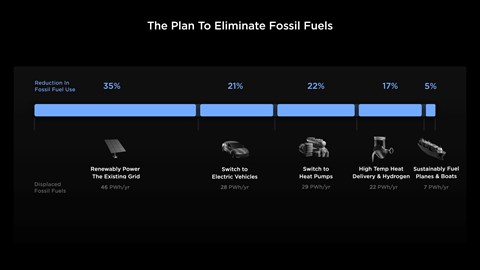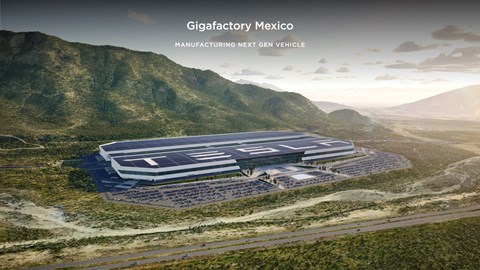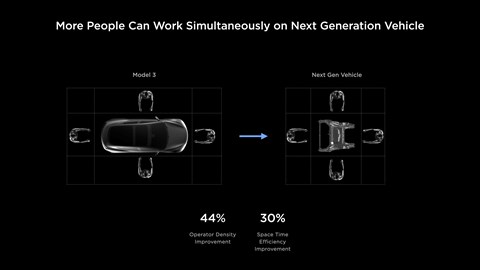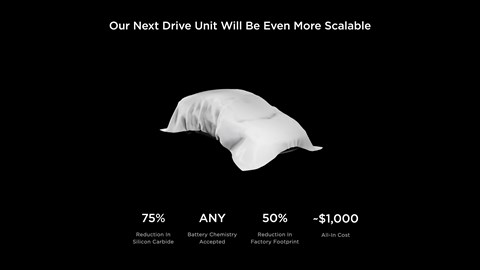► New entry-level Tesla could cost under £22000
► To be built in Berlin factory
► Would sit underneath Models 3 and Y
A new entry-level Tesla electric car is planned, for production in the brand’s European factory near Berlin. That’s according to an unnamed source speaking to Reuters, which claimed ‘knowledge of the matter’.
It’s suggested that the new model – possibly a previously-teased hatchback – could cost less than 25,000 Euros (£21,676) and would make use of a new innovation that allows Tesla to die cast nearly the entire underbody of the vehicle in one piece, speeding up production and lowering costs.
The source reports that Elon Musk informed staff at the Gruenheide factory of plans to build the new vehicle there when he visited the plant on Friday, November 3. The plant currently builds the Model Y SUV.
The new model – if it comes to fruition – would give Tesla a leg-up against encroaching Chinese competition, which threatens to undercut existing EV manufacturers. The current cheapest Tesla is the Model 3, which retails for £39,990.
However, it wouldn’t be the first time Musk has made lofty promises and not delivered. Tesla’s Roadster and Cybertruck are both several years behind the company’s ambitious promised schedule – and the enigmatic CEO has nearly a decade-long streak of promising fully autonomous vehicles ‘this year’. We’ll update this story when we know more about the potential new entry-level Tesla.
For now, keep reading for the latest news of Tesla’s current strategies.
Tesla Investor Day 2023
Elon Musk has shared his vision of a sustainable global strategy called the Master Plan Part 3, while also teasing a new platform for Tesla. Musk revealed both at the brand’s annual Investor Day event, which focused on a plan for a fossil-fuel-free global economy – and the role Tesla will play in it. The all-encompassing event also featured updates on the company’s AI work, as well as new footage of ‘Optimus’ the company’s humanoid robot.

It’s a newly-developed platform CEO Musk says will simultaneously drive down unit costs and greatly improve production output – avoiding the Model 3’s rocky period of Production Hell.
Tesla says its next-gen cars will be far easier and cheaper to produce, and meaning they’ll also cost less too. Tesla brand has already teased a new hatchback model in a social media post, likely to slot well below the £42,000 Model 3 – making it the brand’s cheapest car. It’ll also be the first reveal since the Cybertruck, which should go into production this year.
Unlike the Model 3, which was designed to be hand built but later produced with automation, next-gen cars – like the one mentioned above – will been designed with automation in mind. Tesla says the new platform will begin production in a new factory in Mexico.

How does it work?
As you’d expect these efficiencies come from a holistic approach, with small gains across the board. ‘When you watch [the current Model Y process] happen, it’s actually really silly to a guy like me,’ said Tesla’s vice president of vehicle engineering, Lars Moravy. ‘If we’re going to scale the way we want to do, we have to rethink manufacturing again. We started this on Model Y when we made these huge kicker castings and we deleted hundreds of parts.
We simplified assembly with the model Y structural battery, where we decided the floor should be a part of the car. The battery is the floor. We put the seats in the interior on the battery, and we bring it up through a big open hole and we assemble it. This allowed us to do things in parallel, fully rethinking the process and reducing the final assembly line by about 10%. And we thought maybe we could do this other places.’

Moravy said this method of manufacturing brings an in worker density which means less time doing nothing, and more cars produced: ‘We get 44% more operator density which means more work, less time walking back to the station, and a 30% improvement in space time efficiency,’ he added.
‘It leads us to a greater than 40% reduction in footprint, which means we can build factories faster with less Cap X and more output per unit.’
The next-generation platform goes a step further; factory processes will be refined and streamlined, with more people able to work on components of the car at once: ‘When you have a car that’s about five metres long, you have people working around it like we did in Model 3,’ said Moravy. ‘And we’ll change that to this process where we take different parts of the car, and we can do more at the same time like we did with the Model Y structural battery pack. We can get more people working on the car – or robots working on it – at the same time.’
Alongside more efficient production processes, the next-gen platform will also feature more parts and controllers designed in-house, thus reducing the amount of wiring and labour required.
‘For Cybertruck, we are now designing 85% of the controllers on the car,’ said Pete Bannon, director at Tesla. ‘For the next-gen platform, we’re going to finish the job and will be designing 100% of the controllers to give us full control of the design and the supply chain. Having full control the supply chain at the component level has been critical to Tesla over the last few years, as the supply constraints have hampered our ability to build cars.’
How much will it cost?
Marvay says the new production solution is a two for one concept: As well as being faster, it’ll be cheaper too. It should help reduce costs by as much as 50% – making the brand’s widely rumoured £20,000 EV significantly more feasible.
What about the powertrain?
Tesla also revealed it’s working on a new powertrain that’ll be cheaper to produce, more efficient and less reliant on rare earth metals. It all comes from the company’s vertically stacked approach to manufacturing. ‘Our powertrain and our powertrain manufacturing equipment is both designed under one roof,’ said Colin Campbell, Tesla’s vice-president of powertrain engineering. ‘Engineers who are designing the motor are in the same room as the engineers who are designing the machine that’s going to put that motor together,’ he added.

Tesla says its new powertrain will use 75% less Silicon Carbide than before and will also be compatible with any battery chemistry – making it less sensitive to changes in cell sourcing. The drive unit cost should also drop to around $1000.
‘If we can build the same number of cars from a smaller factory, we are going to be able to scale EV production faster,’ added Campbell. ‘Our next powertrain factory is 50% smaller than the one that’s behind me today, even though it has the same capacity.’
The next generation permanent motor should require no rare earth metals at all.
Tesla reviews